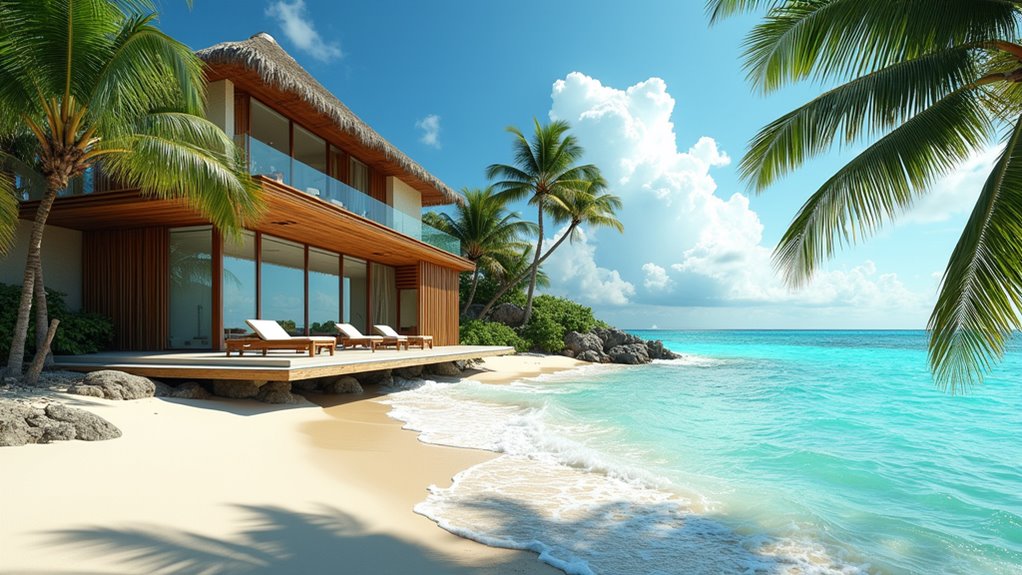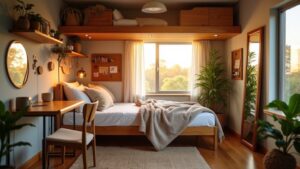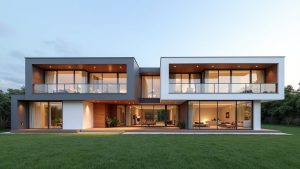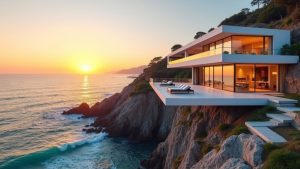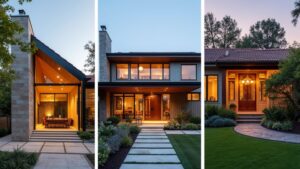Coastal living in the Philippines inspires breathtaking beach house designs that fuse tropical allure with modern elegance. Imagine modern Bahay Kubo renditions on stilts, blending bamboo and glass for airy openness. Tropical modernist homes flaunt minimalist coastal lines, while sustainable retreats use reclaimed wood and solar power. Seamless indoor-outdoor spaces merge patios with lush gardens, and resilient structures defy storms. Cultural touches like Capiz windows dazzle. Explore further to uncover deeper design wonders.
Key Takeaways
- Embrace modern Bahay Kubo designs with elevated structures and Capiz shell windows for ventilation and cultural charm.
- Opt for tropical modernist aesthetics using glass and wood for transparency and warmth in coastal settings.
- Design minimalist coastal lines with seamless indoor-outdoor spaces via sliding glass doors for breathtaking views.
- Incorporate sustainable materials like bamboo and solar panels for eco-friendly beachside havens.
- Use resilient structures with hip roofs and passive cooling strategies for safety and comfort against harsh weather.
Modern Bahay Kubo Inspirations

As the timeless charm of the Bahay Kubo evolves, modern inspirations breathe new life into this iconic Filipino dwelling, blending heritage with innovation.
Once crafted solely from bamboo and nipa, today’s iterations embrace modern materials like steel mimicking bamboo, wood-plastic composite flooring, and concrete stilts for enduring strength. These choices preserve the elevated structure and airy openness while ensuring resilience against coastal elements.
Beyond durability, functionality blooms with designs tailored for contemporary living. Flexible spaces transform effortlessly—garages morph into event venues, while balconies extend the indoors to ocean vistas.
Large windows invite natural light, and open layouts maintain the communal spirit, now paired with modern plumbing and insulation. The steep thatched roof persists, deflecting heat, while sustainable touches like passive cooling honor the Bahay Kubo’s eco-conscious roots. Drawing from global architectural discourse, such as themes explored in the Berkeley Prize Essay Competition, these designs also reflect a commitment to addressing socially relevant issues in modern coastal living.
This fusion crafts a beach house that whispers tradition yet stands boldly in the present. Additionally, the use of local materials continues to support eco-friendly construction, reflecting the sustainable ethos of the traditional design.
Tropical Modernist Aesthetics

Tropical Modernist Aesthetics in beach house design captivate with minimalist coastal lines that echo the serene horizon, crafting a silhouette of simplicity against the vast seascape.
The fusion of glass and wood emerges as a poetic dialogue between transparency and warmth, where expansive panes invite the ocean’s shimmer indoors while rich timber frames ground the space in natural elegance.
Breezy open layouts further enhance this vision, allowing air and light to weave through unobstructed spaces, creating an ethereal connection to the surrounding tropical embrace.
Minimalist Coastal Lines
Embracing the serene beauty of the shore, Minimalist Coastal Lines within the realm of Philippine Tropical Modernism weave a harmonious blend of simplicity and nature.
This approach to coastal design celebrates minimalist aesthetics with clean, geometric forms and uncluttered spaces, embodying the Filipino “maaliwalas” concept of brightness and openness.
Seamless indoor-outdoor connections through expansive windows and verandas invite the tropical breeze and coastal vistas into airy layouts. High ceilings and pale exteriors in whites and beiges enhance light and space, while natural materials like bamboo and rattan add subtle warmth.
Thoughtfully designed for the climate, these homes prioritize ventilation and functionality, ensuring every element serves a purpose.
The result is a tranquil, modern sanctuary that mirrors the sea’s serene expanse.
Glass and Wood Fusion
Numerous Philippine beach houses exemplify the captivating Glass and Wood Fusion, a hallmark of Tropical Modernist Aesthetics, where the interplay of transparent and organic elements crafts an ethereal coastal charm.
This design ethos marries the warmth of narra or bamboo with vast glass expanses, framing mesmerizing ocean vistas while inviting natural light to dance within.
Key elements of this style include:
- Wooden Textures: Rich timber accents and beams add organic depth, echoing traditional Filipino craftsmanship.
- Glass Panoramas: Floor-to-ceiling windows blur boundaries, enhancing outdoor living with seamless nature connections.
- Sustainable Harmony: An eco conscious design emerges through natural materials and ventilation-focused glazing, tailored for tropical climates.
This fusion creates serene spaces, uniting modernity with the Philippines’ coastal allure.
Breezy Open Layouts
As the essence of coastal living unfolds, Breezy Open Layouts emerge as a defining feature of Tropical Modernist Aesthetics, weaving together the beauty of unhindered space with the practicality of climate-responsive design.
These layouts invite coastal breezes to dance through open floor plans, ensuring natural ventilation with strategic window placements and high ceilings that let warm air escape.
Seamless transitions between indoor and outdoor spaces, like verandas and courtyards, blur boundaries, enhancing light and air while exuding relaxed elegance.
Minimalist yet functional, the design employs local materials and passive cooling, avoiding mechanical reliance.
Elevated foundations and thoughtful orientations further harmonize with the tropical climate, crafting homes that breathe with the rhythm of the sea.
Incorporating natural lighting strategies maximizes sunlight through sun-facing windows, reducing energy costs while brightening living spaces.
Sustainable Coastal Retreats

Under the canopy of sustainable coastal retreats, beach house designs embrace eco-friendly material choices, weaving in bamboo and reclaimed wood to craft structures that whisper harmony with the earth.
Rainwater harvesting systems, artfully integrated into the architecture, capture the ocean’s misty tears, ensuring a gentle footprint on precious resources.
Meanwhile, passive cooling strategies, with breezy open layouts and strategic shading, invite the sea’s breath to cool interiors, painting a serene portrait of energy-conscious living.
Eco-Friendly Material Choices
How can one craft a coastal retreat that harmonizes with nature’s rhythm while embracing sustainability?
In the Philippines, eco-friendly material choices for beach houses blend aesthetic allure with environmental stewardship. Architects and homeowners are turning to sustainable options that mirror the coastal serenity, prioritizing resources that endure the salty breeze.
Explore these inspired selections for a greener seaside haven:
- Bamboo Innovations: Utilizing durable, rapidly renewable Bayog timber, treated against pests, for structural elegance.
- Recycled Aesthetics: Reclaimed shipwreck wood and plastic bricks transform waste into charming, resilient designs.
- Local Treasures: Nipa palm roofing and sawali walls ensure ventilation and a reduced carbon footprint.
Such materials weave a narrative of sustainability, crafting retreats that resonate with the ocean’s timeless whisper.
Rainwater Harvesting Systems
Serenity weaves through the design of a coastal retreat when rainwater harvesting systems become an integral element. These sustainable systems, tailored for Philippine shores, capture nature’s bounty via sleek metal roofs and filtered gutters, guiding water into sturdy cisterns. Rainwater management transforms abundant rainfall into a resource, reducing municipal dependency and guarding against coastal erosion with every drop stored.
Imagine the harmony of self-sufficiency with the ocean’s whisper nearby. Below, a vision of connection unfolds:
| Element | Purpose | Emotion Evoked |
|---|---|---|
| Catchment Roof | Gathers rain’s gift | Awe of nature’s cycle |
| Conveyance Gutters | Channels life’s flow | Trust in seamless design |
| Storage Tanks | Holds liquid treasure | Security in abundance |
| Filtration Screens | Purifies with care | Peace in purity |
| Distribution Pipes | Delivers to every corner | Joy of endless provision |
Passive Cooling Strategies
As the tropical sun blazes over Philippine shores, passive cooling strategies emerge as essential artistry in crafting sustainable coastal retreats.
These designs weave nature’s breath into architecture, tempering the heat with elegance. Beach houses, oriented north-south, evade the fierce eastern and western rays, while their narrow forms invite breezes to dance through.
Innovative approaches include:
- Natural Ventilation: Strategic openings, like jalousie windows and ventanillas, harness cross-ventilation, guiding cool air through spaces as warm air escapes via high vents.
- Shading Techniques: Overhanging eaves and lush vegetation cloak walls, deflecting solar heat with a verdant embrace.
- Elevated Designs: Inspired by Bahay Kubo, raised structures enhance airflow beneath, guarding against coastal floods.
Such methods blend tradition with sustainability, crafting serene, cool havens.
Seamless Indoor-Outdoor Spaces

While the ocean whispers beyond the horizon, beach house design excels in crafting seamless indoor-outdoor spaces that dissolve the barriers between home and nature.
Expansive sliding glass doors and floor-to-ceiling windows frame breathtaking coastal vistas, flooding interiors with light and forging a deep connection to the sea. Open-plan layouts in living areas extend effortlessly to patios and verandas, while seamless flooring weaves visual harmony from inside to out.
Transitional spaces like decks and outdoor kitchens enhance alfresco living, blending functionality with outdoor aesthetics. Indoor gardens breathe life into homes, their lush greenery echoing the tropical surroundings, while natural materials like bamboo and woven fibers ground the design in local charm.
Wide eaves shade sunlit openings, and strategic windows invite cooling breezes, ensuring comfort. With earthy tones and minimalist decor, these spaces weave an unbroken tapestry of nature and shelter, embodying coastal serenity.
Resilient Seaside Structures

Beyond the allure of coastal vistas, beach houses must stand as bastions against the relentless forces of nature. In the Philippines, where typhoons and flooding threaten seaside havens, resilient architecture is paramount. Elevated designs rise as a poetic shield, lifting homes above the reach of storm surge with stilts or pilings, safeguarding against water’s wrath while preserving the natural terrain.
Strength whispers through reinforced concrete, steel frames, and hurricane straps, anchoring dreams against howling winds.
To weave resilience into beauty, consider:
- Soaring Foundations: Elevated designs on piers, defying storm surge with grace, transforming lower spaces into shaded retreats.
- Unyielding Materials: Metal roofing and structural panels, kissed by salt air, standing firm against gales up to 200 mph.
- Steadfast Roofs: Hip roofs with steep angles, deflecting wind’s fury, their tiles whispering endurance through torrential rains.
Thus, coastal homes become fortresses, harmonizing safety with the sea’s untamed splendor.
Cultural and Vernacular Touches

Coastal abodes, having been fortified against nature’s tempests, also bear the soul of their cultural lineage through vernacular touches that echo the Philippines’ rich heritage. Inspired by the iconic Bahay Kubo, these homes often feature elevated structures on bamboo stilts, ensuring ventilation and flood resilience, while open layouts and Capiz shell windows invite the sea breeze and soft light.
The steep, thatched roofs of nipa palm offer a tropical silhouette, blending seamlessly with the coastal vista.
Beyond structure, cultural motifs shine through intricate wood carvings and woven Solihiya patterns in furniture, reflecting indigenous craftsmanship passed down through generations.
Bahay na Bato influences add elegance with stone bases and hardwood upper levels, complemented by ventanillas for airflow.
Decorative accents of rattan, abaca, and pearlescent Capiz inlays weave a narrative of local artistry, transforming beach houses into timeless sanctuaries of Filipino identity amidst the rhythmic waves.
Modern adaptations often incorporate sustainable materials like bamboo and rattan, blending traditional design with eco-friendly practices for lasting cultural significance.
Eco-Friendly Beachside Havens

Numerous beach houses along the Philippine coast are embracing a harmonious blend of nature and innovation, transforming into eco-friendly havens that honor the environment.
With sustainable materials like bamboo and reclaimed wood, these homes weave durability into their aesthetic charm. Passive design, such as cross-ventilation and wide eaves, captures ocean breezes, cooling spaces naturally under the tropical sun. Solar panels harness abundant sunlight, powering lives with renewable energy.
These coastal retreats blend seamlessly with their surroundings through mindful choices, such as:
- Beachfront landscaping with drought-tolerant native plants, reducing water needs while framing stunning sea views.
- Eco friendly furnishings crafted from recycled or sustainably sourced materials, adding earthy elegance to interiors.
- Rainwater harvesting systems, collecting nature’s bounty for irrigation and household use.
Such designs not only minimize environmental impact but also create serene sanctuaries, where the rhythm of the waves echoes in every sustainable detail.
